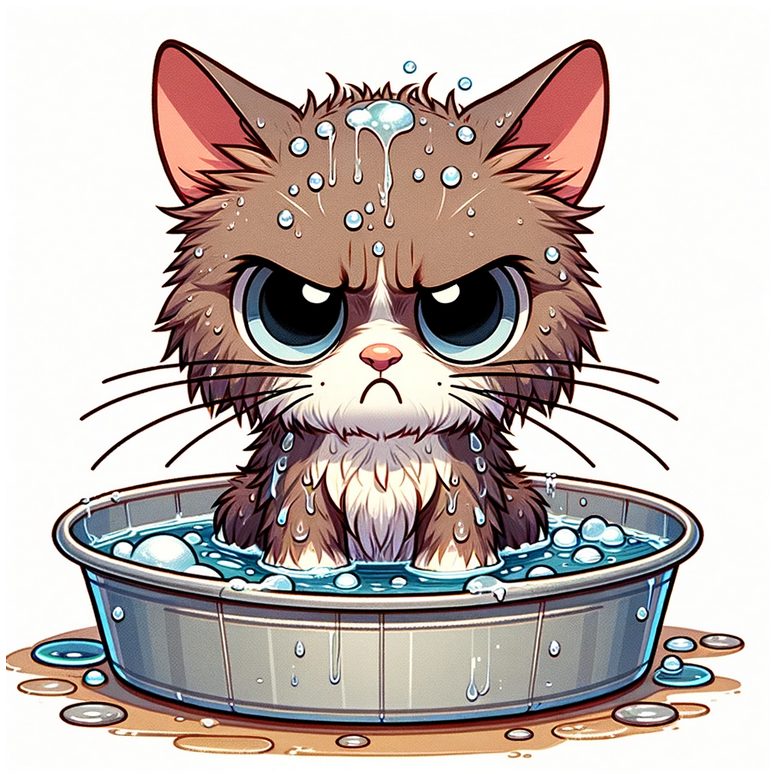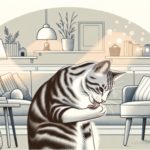Cats are fascinating creatures, known for their agility, curiosity, and distinctive personalities. Among their many quirks, one particular trait stands out: most cats have a notorious dislike for water. This aversion can pose challenges for pet owners, especially when bathing becomes necessary due to age, skin conditions, or coat type. Let’s explore some of the reasons behind why cats hate water. Then we will explore strategies that may help acclimate your cat to bathing. And, finally, we will discuss alternative cleaning methods for senior cats who can no longer self-groom.

Reasons Why Cats Dislike Water
- Historical Adaptation: Unlike dogs, most cats have not been historically adapted to water. Their ancestors lived in dry, arid regions where encounters with large bodies of water were rare. This lack of exposure has contributed to their general dislike of water.
- Coat Saturation: A cat’s fur gets heavily saturated when wet, making it heavier and uncomfortable. This can lead to a feeling of unease or panic as it significantly alters their mobility and agility, which cats highly value.
- Temperature Sensitivity: Cats are more sensitive to changes in temperature. Getting wet can cause a sudden drop in their body temperature, leading to discomfort or stress.
- Unpleasant Experiences: If a cat’s first exposure to water is traumatic or forced, it may develop a lifelong aversion. Negative experiences can have a lasting impact on a cat’s perception of bathing.
- Instinctive Caution: Cats are naturally cautious creatures, especially around large bodies of water or unfamiliar situations. This caution can extend to bathtubs or even shallow bowls of water.
- Smell Sensitivity: Cats have a highly developed sense of smell. The chemicals or scents in tap water or bathing products can be off-putting to them, making the experience unpleasant.
Acclimating Your Cat to Bathing
- Start Early: If possible, introduce your cat to water at a young age. Gradual exposure can help them become more comfortable over time.
- Use Positive Reinforcement: Reward your cat with treats and affection during and after the bath to create positive associations with bathing.
- Make It Comfortable: Use warm (not hot) water and a non-slip mat in the bathtub. Keeping the water level low can also help reduce anxiety.
- Be Quick and Calm: Cats can sense stress, so it’s important to remain calm. Make the bathing process as quick and efficient as possible to minimize discomfort.
- Dry Them Thoroughly: After bathing, gently towel dry your cat or use a hairdryer on a low, cool setting to help them get dry faster.
Alternative Cleaning Methods for Senior Cats
- Grooming Wipes: Pet-safe grooming wipes can be a gentle way to clean your cat without the stress of a full bath. They’re useful for spot cleaning and areas that need attention.
- Dry Shampoo: Specially formulated dry shampoo for cats can help clean their coat without water. It’s a less invasive method that can still help maintain their hygiene.
- Brushing: Regular brushing helps remove dirt, grease, and dead hair from your cat’s coat. It’s also a great way to bond with your cat while keeping their fur clean.
- Professional Grooming: If your senior cat struggles with self-grooming, consider professional grooming services. Groomers are experienced in handling cats and can provide a stress-free cleaning experience.
Conclusion
Understanding why cats dislike water and how to address these concerns is crucial for any cat owner. By introducing water gradually, creating a positive bathing experience, or using alternative cleaning methods, you can help your cat stay clean and healthy with minimal stress. Remember, each cat is unique, and what works for one may not work for another. Patience and understanding are key to finding the best approach for your feline friend.
For further reading and to ensure you’re using the best practices and products, consult with your veterinarian or a professional pet groomer. They can offer tailored advice based on your cat’s specific needs and health conditions.






